Watercolor painting
This article includes a list of general references, but it lacks sufficient corresponding inline citations. (October 2019) |


Watercolor (American English) or watercolour (British English; see spelling differences), also aquarelle (French: [akwaʁɛl]; from Italian diminutive of Latin aqua 'water'),[1] is a painting method[2] in which the paints are made of pigments suspended in a water-based[3] solution. Watercolor refers to both the medium and the resulting artwork. Aquarelles painted with water-soluble colored ink instead of modern water colors are called aquarellum atramento (Latin for "aquarelle made with ink") by experts. However, this term has now tended to pass out of use.[4][5]
The conventional and most common
Watercolor paint is an ancient form of painting, if not the most ancient form of art itself.
Many Western artists, especially in the early 19th century, used watercolor primarily as a sketching tool in preparation for the "finished" work in oil or engraving.[15] Until the end of the eighteenth century, traditional watercolors were known as 'tinted drawings'.[16]
History
Watercolor art dates back to the cave paintings of paleolithic Europe
Despite this early start, watercolors were generally used by Baroque easel painters only for sketches, copies or
English school
Several factors contributed to the spread of watercolor painting during the 18th century, particularly in England.[23] Among the elite and aristocratic classes, watercolor painting was one of the incidental adornments of a good education; mapmakers, military officers, and engineers valued it for its usefulness in depicting properties, terrain,[24] fortifications, field geology, and for illustrating public works or commissioned projects. Watercolor artists were commonly taken on geological or archaeological expeditions, funded by the Society of Dilettanti (founded in 1733), to document discoveries in the Mediterranean, Asia, and the New World. These expeditions stimulated the demand for topographical painters, who churned out memento paintings of famous sites (and sights) along the Grand Tour to Italy that was undertaken by every fashionable young man of the time.[25]
In the late 18th century, the English cleric

From the late 18th century through the 19th century, the market for printed books and domestic art contributed substantially to the growth of the medium.[33] Watercolors were used as the basic document from which collectible landscape or tourist engravings were developed, and hand-painted watercolor originals or copies of famous paintings contributed to many upper class art portfolios. Satirical broadsides by Thomas Rowlandson, many published by Rudolph Ackermann, were also extremely popular.
The three English artists credited with establishing watercolor as an independent, mature painting medium are
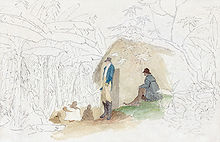
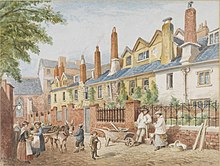
The confluence of amateur activity, publishing markets, middle class
The popularity of watercolors stimulated many innovations, including heavier and more

United States
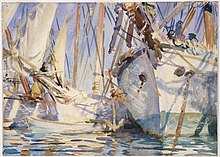
Watercolor painting also became popular in the United States during the 19th century; outstanding early practitioners included
.Europe
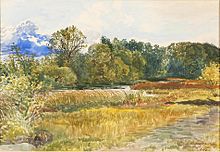
Watercolor was less popular in Continental Europe. In the 18th century,

The adoption of brightly colored, petroleum-derived aniline dyes (and pigments compounded from them), which all fade rapidly on exposure to light, and the efforts to properly conserve the twenty thousand J. M. W. Turner paintings inherited by the British Museum in 1857, led to a negative reevaluation of the permanence of pigments in watercolor.[52] This caused a sharp decline in their status and market value. Nevertheless, isolated practitioners continued to prefer and develop the medium into the 20th century. Paul Signac created landscape and maritime watercolors, and Paul Cézanne developed a watercolor painting style consisting entirely of overlapping small glazes of pure color.
20th and 21st centuries
Among the many 20th-century artists who produced important works in watercolor were
Although the rise of abstract expressionism, and the trivializing influence of amateur painters and advertising- or workshop-influenced painting styles, led to a temporary decline in the popularity of watercolor painting after c. 1950,[59] watercolors continue to be utilized by artists like Martha Burchfield, Joseph Raffael, Andrew Wyeth, Philip Pearlstein,[60] Eric Fischl, Gerhard Richter, Anselm Kiefer, and Francesco Clemente. In Spain, Ceferí Olivé created an innovative style followed by his students, such as Rafael Alonso López-Montero and Francesc Torné Gavaldà. In Mexico, the major exponents are Ignacio Barrios, Edgardo Coghlan, Ángel Mauro, Vicente Mendiola, and Pastor Velázquez. In the Canary Islands, where this pictorial technique has many followers, there are stand-out artists such as Francisco Bonnín Guerín, José Comas Quesada, and Alberto Manrique.
Watercolor paint
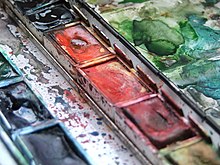
Watercolor paint consists of four principal ingredients:, hiding, durability or color of the pigment and vehicle mixture; and, evaporating water, as a solvent used to thin or dilute the paint for application.
The more general term .
The term "watercolor" refers to paints that use water-soluble, complex carbohydrates as a binder. Originally (in the 16th to 18th centuries), watercolor binders were sugars and/or hide glues, but since the 19th century, the preferred binder is natural
The term "
Commercial watercolors
Watercolor painters before the turn of the 18th century had to make paints themselves using pigments purchased from an
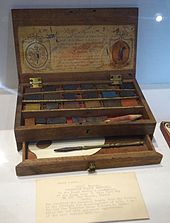
Modern commercial watercolor paints are available in tubes, pans and liquids.[67] The majority of paints sold today are in collapsible small metal tubes in standard sizes and formulated to a consistency similar to toothpaste by being already mixed with a certain water component. For use, this paste has to be further diluted with water. Pan paints (actually small dried cakes or bars of paint in an open plastic container) are usually sold in two sizes, full pans and half pans.
Owing to modern
Transparency
In the partisan debates of the 19th-century English art world, gouache was emphatically contrasted to traditional watercolors and denigrated for its high hiding power or lack of "transparency"; "transparent" watercolors were exalted. The aversion to opaque paint had its origin in the fact that well into the 19th century lead white was used to increase the covering quality. That pigment tended to soon discolor into black under the influence of sulphurous air pollution, totally ruining the artwork.[68] The traditional claim that "transparent" watercolors gain "luminosity" because they function like a pane of stained glass laid on paper—the color intensified because the light passes through the pigment, reflects from the paper, and passes a second time through the pigment on its way to the viewer—is false. Watercolor paints typically do not form a cohesive paint layer, as do acrylic or oil paints, but simply scatter pigment particles randomly across the paper surface; the transparency is caused by the paper being visible between the particles.[69] Watercolors may appear more vivid than acrylics or oils because the pigments are laid down in a purer form, with few or no fillers (such as kaolin) obscuring the pigment colors. Typically, most or all of the gum binder will be absorbed by the paper, preventing the binder from changing the visibility of the pigment.[69] The gum being absorbed does not decrease but increase the adhesion of the pigment to the paper, as its particles will then penetrate the fibres more easily. In fact, an important function of the gum is to facilitate the "lifting" (removal) of color, should the artist want to create a lighter spot in a painted area.[69] Furthermore, the gum prevents flocculation of the pigment particles.[69]
See also
- Acrylic painting techniques
- History of painting
- Ink wash painting
- Oil painting
- Category:Watercolorists
References
- ^ "aquarelle". Oxford English Dictionary (Online ed.). Oxford University Press. (Subscription or participating institution membership required.)
- ^ a b "Watercolor may be as old as art itself, going back to the Stone Age when early ancestors combined earth and charcoal with water to create the first wet-on-dry picture on a cave wall." London (2021, p. 19)
- ^ "Ancient Egyptians used water-soluble translucent paints to decorate papyrus scrolls. They used such earth pigments as ochres and siennas, as well as minerals like reds, cinnabar, blue azure, green malachite, and so on, with gum arabic and egg white. Technically, these water-soluble colors were watercolors." London (2021, p. 19)
- ^ Ling (1991)
- ^ Waterhouse (1994)
- ^ "100% cotton papers are more absorbent in most brands, but there are papers that have only 50% cotton or even high quality papers, which have no blending with cotton." Viscarra (2020, p. 21)
- ^ Vloothuis, Johannes (2017-07-14). "Understanding the Different Grades of Watercolor Paper". Artists Network. Retrieved 2018-10-03.
- ^ "Watercolor Paper: How to Choose the Right Paper for Use with Watercolors". art-is-fun.com. Art Is Fun. Archived from the original on 2015-10-07. Retrieved 2015-10-06.
- ^ "I would not recommend a weight less than 140lb (300 gsm) to paint anything other than quick sketches." Mann (2016)
- ^ "a paper that weighs 300 grams x meter² (140 pounds), has more body and looks more like a cardboard or thin cardboard, which makes it better to support the use of water." Viscarra (2020, p. 17)
- ^ "It consists of a mixture of pigments, binders such as gum arabic and humectants such as glycerin, which together with other components, allow the color pigment to join and form the paint paste, which we know as watercolor. With regard to the colors, the quality of the pigments and their degree of concentration, it is what determines how good the watercolor is and also its price. A paint that has a high concentration of pigment, professional type, allows us to use it with a large amount of water without losing the intensity of color." Viscarra (2020, p. 47)
- ^ "Turner himself was of the same opinion; he declared to me [Munro] that water-colour painting would be totally mined, and lose all its individuality and beauty by the bad practice of mingling opaque with transparent colour." Redgrave & Redgrave (1866)
- ^ "With the discovery of paper in China around 2000 years ago, the watercolor media took a different route in which the color of the paper played an important role." London (2021, p. 19)
- ^ "Watercolors on silk were frequently used by Chinese and Japanese artists. Their artworks often included calligraphy as well as peaceful nature scenes, animals, and pictures of everyday life." London (2021, p. 21)
- ^ "What Is Watercolor?". collectorsguide.com. The Collector's Guide.
- ^ "They had a limited range of colours that did not replicate those found in nature and the colours were never applied at their maximum intensity. Moorby et al. (2010, p. 43)
- ^ "In its simplest form, watercolour was used in Europe more than 10,000 years ago when cave-dwellers of the Upper Palaeolithic era mixed red earth with water and used it to paint pictures of hunters and their prey on the cave walls." Chaplin (2001, p. 6)
- ^ "Monks used watercolor and body color to brighten hand-written texts and manuscripts during the European Middle Ages. London (2021, p. 21)
- ^ "The origins of European watercolor, as we understand it now, may be traced back to the Northern Renaissance. Albrecht Durer (1471-1528), a German artist, was among the first to discover the possibilities of this medium. London (2021, p. 21)
- ^ During the Baroque era, watercolor was frequently used to decorate naturalist books, albums, and scientific publications, as well as to create hand-painted maps and building drawings. Watercolor portraiture on paper, vellum, and ivory was also quite popular. London (2021, p. 23)
- ^ Anthony Van Dyck (1599 - 1641), a Flemish artist, improved the watercolor painting method by incorporating transparent washes. This was a noteworthy advance in which painters allowed the color of the paper to show through pigments and play a major role in the artwork. London (2021, p. 23)
- ^ Watercolor was practiced by such masters as Claude Lorrain (1600 or 1604/5 - 1682), Giovanni Benedetto Castiglione (1609 - 1664), and many more Dutch and Flemish baroque artists. London (2021, p. 24)
- ^ "Yet in the Christian era in Britain, it was not appreciated as an art medium in its own right until the 19th century, when Queen Victoria gave the royal seal of approval that brought it firmly into the purview of the art establishment." Chaplin (2001, p. 6)
- ^ "By the 18th century, watercolour was well established as a means of making a topographical view of the landscape." Chaplin (2001, p. 6)
- ^ "While families making the Grand Tour of Europe took along their art tutor, in effect to provide the holiday photographs, professional artists such as Alexander Cozens (1717–1786) and Francis Towne (1740–1816) travelled extensively in Italy. It became part of the English tradition that one went abroad to do watercolour paintings of exotic ruins – except that they were known as watercolour drawings, as the medium was not even dignified by the recognition that it was paint". Chaplin (2001, p. 6)
- ^ "Turner's apprentice years in the 1790s coincided with the fashion for all things 'Picturesque', an aesthetic taste propagated by William Gilpin (1724–1804), which embraced asymmetrical, broken forms and rough textures, and was epitomised by tumbledown cottages and the ruined abbey-churches laid waste in the Reformation." Moorby et al. (2010, p. 167)
- ^ "The artist who most truly brought the eighteenth-century tradition of figurative composition into the early years of the nineteenth century was William Blake." Reynolds (1998)
- ^ "Many more artists influenced the English watercolor style, including Thomas Gainsborough (1727-1788), William Pars (1742-1782), John Sell Cotman (1782-1842), and Samuel Prout (1783–1852)." London (2021, p. 24)
- ^ "professional artists such as Alexander Cozens (1717–1786) and Francis Towne (1740–1816) travelled extensively in Italy." Chaplin (2001, p. 6)
- ^ "His study of stonework from the gateway at Battle Abbey, for example, is a colour exercise derived from an earlier watercolour by the eighteenth-century topographical painter, Michael Angelo Rooker (1746– 1801). Using part of Rooker's composition as a starting point, Turner has perfected the process of building up a picture using one application of colour at a time, gradually moving through a scale of tonality from light to dark." Moorby et al. (2010, p. 18-19)
- ^ "Hearne's style is even more precise and unperturbed than Rooker's. He was born a year or two before Rooker, emerged into public notice about 1765, and after his foreign voyage settled down to a long life of drawing the places of interest in Great Britain, many for a well-known publication called Antiquities of Great Britain, to which he was still contributing as late as 1807." Reynolds (1998)
- ^ "John 'Warwick' Smith has long been supposed to owe his nickname to the circumstance of his patronage by Lord Warwick, though it may come from his birthplace near the village of Warwick in Cumberland. He was in Rome from 1777 to 1781 and again in 1783. He shows the marks of his travel by an interest in Italian methods of composing landscape and in an enhanced sense of colour (Fig. 23) Reynolds (1998)
- ^ "In 1799 the Napoleonic Wars broke out and Europe was closed to the British traveller." Chaplin (2001, p. 7)
- ^ "He was born in London on 23 April 1775, and given the names Joseph Mallord William Turner. His family called him William but he is now usually referred to by initials as J. M. W. Turner." Reynolds (2020, p. 19)
- ^ "Girtin and Turner in particular explored the capacity of watercolour for creating atmospheric effects, experimenting with texture and colour." Chaplin (2001, p. 8)
- ^ "The seemingly effortless freshness of these watercolours disguises the rigorous planning stage that lies behind them. For, between the pencil sketches and the finished watercolours, Turner evolved a creative process that enabled him to experiment in an open-ended fashion with the structure and relative dispositions of colour and light." Moorby et al. (2010, p. 26)
- ^ "One charming account recalls how Turner would hang up his moist studies on cords spread across his room, so that his drying sheets, stained with 'pink and blue and yellow', would at first glance resemble the laundry of a washerwoman." Moorby et al. (2010, p. 26)
- ^ "John Varley (1778–1842), Thomas Girtin (1775–1802), John Sell Cotman (1782–1842) and David Cox (1783–1859) ushered in the golden age of British watercolour". Chaplin (2001, p. 7)
- ^ "When it is remembered that men of such diverse gifts and temperaments as David Cox and Samuel Palmer, F.O. Finch and Copley Fielding were his [John Varley] pupils it will be apparent that he did not impose his own vision on his scholars but, as education truly signifies, drew out of them what was latent in them." Reynolds (1998)
- ^ "William Havell was, at the age of twenty-three, the youngest of the exhibiting members in 1805. His work typifies the common approach of the members of the Society: the dependence of composition on the seventeenth-century landscape painters, the aspiration to vie with oil paintings, the rich tonality of the piece." Reynolds (1998)
- ^ "By the nineteenth century, watercolor had become so popular that several art societies were formed, including the Society of Painters in Water Colours (1804, now the Royal Watercolour Society), the New Water Colour Society (1832, now the Royal Institute of Painters in Water Colours), and the Scottish Society of Painters in Water Colours (1878, now the Royal Scottish Society of Painters in Watercolour). The Watercolour Society of Ireland (WCSI) was established in Ireland in 1870, and the Ulster Watercolour Society (UWS) was founded in Northern Ireland. The Russian Watercolor Society was formed in St. Petersburg, Russia, in 1880." London (2021, p. 26)
- ^ Reynolds (1992, p. 102)
- ^ "J.S. Cotman was born in Norwich in 1782; and, having decided that he must devote himself to art, came to London at the age of sixteen or seventeen in 1798. Here he was befriended by Dr Monro, and became another instance of that connoisseur's remarkable flair in choosing promising young men. As were Turner and Girtin five years before, he was set to copy outlines and trace drawings." Reynolds (1998)
- ^ "The early nineteenth century Girtin, Turner, Cotman, Cox, De Wint, Constable, Bonington, and the Exhibiting Societies". Reynolds (1998)
- ^ "Lewis and Hunt were forerunners in an aesthetic shift which is apparent in the watercolours of the next thirty years, towards brilliance of colour and minuteness of touch." Reynolds (1998)
- ^ "Birket Foster applies these principles[brilliance of colour and minuteness of touch] to landscapes in which the emphasis is laid on the charm of summer fields and country lanes and the inhabitants are idealized into the best behaved children or worthy, handsome peasantry." Reynolds (1998)
- ^ "In the next generation of artists the acknowledged leader of the illustrative school was Frederick Walker." Reynolds (1998)
- ^ "Although he only lived to be twenty-five, Bonington crystallized the prevailing tendencies of his time so well that he not only left a body of great work behind him but he had a strong influence on his contemporaries and successors both in France and England." Reynolds (1998)
- ^ "Havill Frederick biography".
- ^ "Watercolor extended its reach to the American continent with European painters documenting the "new world", and became popular there in the nineteenth century. In 1866, the American Society of Painters in Watercolor (now the American Watercolor Society) was established. Artists such as James A. M. Whistler (1834-1903), Thomas Moran (1837-1926), Thomas Eakins (1844-1916), John Singer Sargent (1856-1925), and many more had contributed to the American tradition of watercolor by the end of the nineteenth century." London (2021, pp. 26–27)
- ^ Brown, David Blayney. "Watercolour." Grove Art Online. Oxford Art Online. Oxford University Press. Retrieved April 26, 2014.
- . Retrieved 2024-03-10.
- ^ "The European forms of Impressionism and Post-Impressionism were frequently emulated in the United States." London (2021, p. 27)
- ^ "At about the same time, several of new regional schools sprung up." London (2021, p. 27)
- ^ "The Cleveland Museum of Art was the epicenter of the "Cleveland" or "Ohio School" of artists. In 1921, the California Water Color Society was established (now the National Watercolor Society)." London (2021, p. 27)
- ^ Nalewicki, Jennifer. "The Story Behind the World's Largest Watercolor Painting". Smithsonian. Retrieved 2018-07-01.
- ^ "The World's Largest Watercolor Goes on Display at MASS MoCA". Creators. 2017-05-30. Retrieved 2018-07-01.
- ^ "Barbara Ernst Prey Building 6 Portrait: Interior". MASS MoCA. Retrieved 2018-07-01.
- ^ "Watercolor art in the United States declined after the 1950s, giving place to abstract expressionism." London (2021, p. 27)
- ^ "However, artists such as Andrew Wyeth (1917-2009), Philip Pearlstein (born 1924), Joseph Raffael (born 1933), and many others continued to create in this medium." London (2021, p. 27)
- ^ "It consists of a mixture of pigments, binders such as gum arabic and humectants such as glycerin, which together with other components, allow the color pigment to join and form the paint paste, which we know as watercolor." Viscarra (2020, p. 47)
- ^ "Turner's surviving watercolour palettes have been found to contain various gum mixtures that generally include arabic, tragacanth, cherry or sarcocolla, and traces of added sugar." Moorby et al. (2010, p. 38)
- ^ "Gum arabic tends to dry out in the paint and is quite brittle, so the other main ingredient is glycerine, which keeps the paint soluble." Chaplin (2001, p. 25)
- ^ "so ox gall is added as a wetting agent." Chaplin (2001, pp. 25–26)
- ^ Chilvers (2009)
- ^ "...more user-friendly soft watercolour blocks had been introduced by the artists' colourman Reeves." Moorby et al. (2010, p. 40)
- ^ "...in general it can be liquid, creamy in tubes, solid, in the form of pans, chalk pastels, waxes, markers, pencils, etc." Viscarra (2020, p. 47)
- ^ Kraaijpoel & Herenius (2007, p. 187)
- ^ a b c d Kraaijpoel & Herenius (2007, p. 183)
Works cited
- Chaplin, Mike (2001). Painting Expressive Watercolours (Kindle ed.). London: Collins. ASIN B00KV2RLEA.
- Chilvers, Ian (2009). The Oxford Dictionary of Art and Artists. USA: Oxford University Press.
- Kraaijpoel, D.; Herenius, C. (2007). Het kunstschilderboek — handboek voor materialen en technieken (in Dutch). Cantecleer.
- Ling, Roger (1991). Roman Painting. Cambridge University Press.
- London, Vladimir (2021). The Book on Watercolor (Kindle ed.). ]
- Mann, Eleanor (2016). The Watercolour Book: How to Paint Anything (Kindle ed.). ]
- Moorby, Nicola; Chaplin, Mike; Warrell, Ian; Smibert, Tony, eds. (2010). How to Paint Like Turner (Kindle ed.). London: Tate. ASIN B00XULC1FI.
- Redgrave, Richard; Redgrave, Samuel (1866). A Century of Painters of the English School.
- Reynolds, Graham (1992). Watercolours, A Concise History. London: Thames and Hudson.
- Reynolds, Graham (1998). English Watercolors: an introduction (Kindle ed.). New York: New Amsterdam. ASIN B00FF9PY98.
- Reynolds, Graham (2020). Turner (Second, Kindle ed.). London: Thames and Hudson. ASIN B0BDRNNKVW.
- Viscarra, Alejandra (2020). How to Paint in Watercolor from the Beginning (Kindle ed.). ]
- Waterhouse, Ellis Kirkham (1994). Painting in Britain, 1530 to 1790. Yale University Press.
Further reading
History
- Andrew Wilton & Anne Lyles. The Great Age of British Watercolours (1750–1880). Prestel, 1993. ISBN 3-7913-1254-5
- Anne Lyles & Robin Hamlyn. British watercolours from the Oppé Collection. Tate Gallery Publishing, 1997. ISBN 1-85437-240-8
- Christopher Finch. American Watercolors. Abbeville Press, 1991. ASIN B000IBDWGK
- Christopher Finch. Nineteenth-Century Watercolors. Abbeville Press, 1991. ISBN 1-55859-019-6
- Christopher Finch. Twentieth-Century Watercolors. Abbeville Press, 1988. ISBN 0-89659-811-X
- Eric Shanes. Turner: The Great Watercolours. Royal Academy of Arts, 2001. ISBN 0-8109-6634-4
- Martin Hardie. Water-Colour Painting in Britain (3 volumes: I. The Eighteenth Century; II. The Romantic Period; III. The Victorian Period.). Batsford, 1966–1968. ISBN 1-131-84131-X
- Michael Clarke. The Tempting Prospect: A Social History of English Watercolours. British Museum Publications, 1981. ASIN B000UCV0XO
- Moore, Sean. Ultimate Visual Dictionary. Dorling Kindersley, 1994. ISBN 0-7513-1050-6
Tutorials and Technique
- Rex Brandt. The Winning Ways of Watercolor: Basic Techniques and Methods of Transparent Watercolor in Twenty Lessons. Van Nostrand Reinhold, 1973. ISBN 0-442-21404-9
- David Dewey. The Watercolor Book: Materials and Techniques for Today's Artist. Watson-Guptill, 1995. ISBN 0-8230-5641-4
- Donna Seldin Janis. Sargent Abroad: Figures and Landscapes. Abbeville Press; 1st edition (October 1997). ISBN 978-0-7892-0384-7.
- Charles LeClair. The Art of Watercolor (Revised and Expanded Edition). Watson-Guptill, 1999. ISBN 0-8230-0292-6
- Royal Watercolour Society. The Watercolour Expert. Cassell Illustrated, 2004. ISBN 1-84403-149-7
- John Ruskin. The Elements of Drawing [1857]. Watson-Guptill, 1991. ISBN 0-8230-1602-1(Reprints from other publishers are also available.)
- Pip Seymour. Watercolour Painting: A Handbook for Artists. Lee Press, 1997. ISBN 0-9524727-4-0
- Stan Smith. Watercolor: The Complete Course. Reader's Digest, 1995. ISBN 0-89577-653-7
- Curtis Tappenden. Foundation Course: Watercolour. Cassell Illustrated, 2003. ISBN 1-84403-082-2
- Edgar A. Whitney. Complete Guide to Watercolor Painting. Watson-Guptill, 1974. [Dover Edition ISBN 0-486-41742-5]
Materials
- Ian Sidaway. The Watercolor Artist's Paper Directory. North Light, 2000. ISBN 1-58180-034-7
- Jacques Turner. Brushes: A Handbook for Artists and Artisans. Design Press, 1992. ISBN 0-8306-3975-6
- Sylvie Turner. The Book of Fine Paper. Thames & Hudson, 1998. ISBN 0-500-01871-5
- Michael Wilcox. The Wilcox Guide To The Best Watercolor Paints. School of Colour Publications, 2000. ISBN 978-0-9679628-0-1
External links
- American Watercolor Society
- National Watercolor Society (USA)
- Belgian Watercolor Institute
- "Watercolour Painting". Paintings & Drawings. Victoria and Albert Museum. Retrieved 2007-08-21.
